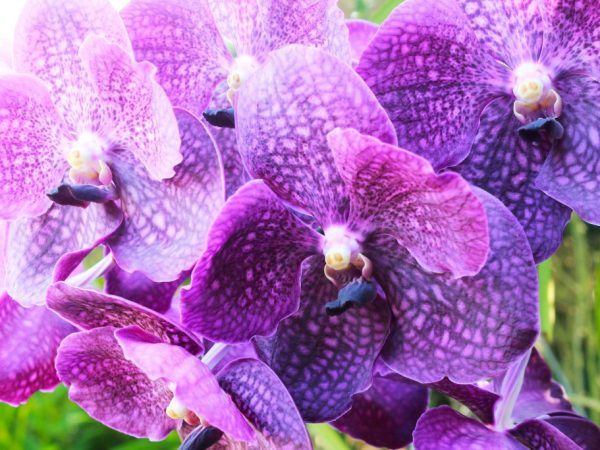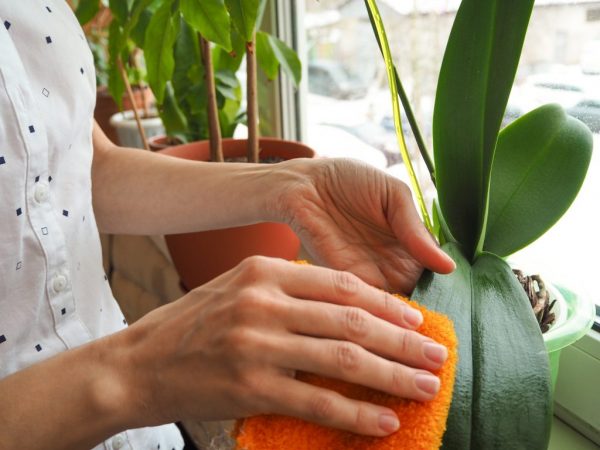Features of watering orchids in winter
For orchids to grow well and bloom for a long time, they need to be properly cared for and create the right living conditions. One of the requirements for plant care is watering. The features of watering vary, depending on the season and the period of the flower's life. Watering your orchid in winter is the most important part of grooming.

Features of watering orchids in winter
Features of caring for orchids in winter
Orchid is a heat-loving flower. In winter, she needs care that is different from caring for a plant in the warm season. Wild orchids and domestic hybrid species have different characteristics. Consequently, their conditions of detention will also differ.
Flowers growing in the wild have adapted to climatic conditions and are accustomed to extreme temperature changes. For their full growth, development and flowering in certain periods, a significant and long-term decrease in air temperature is vital. Unlike wild plants, indoor phalaenopsis are not adapted to the cold, therefore it is advisable to create special conditions for them in winter: high air temperature and humidity level.
How to properly water an orchid in winter
After watering in winter, flower pots should not be placed on the windowsill. In this case, it is important to monitor the condition of the substrate and the level of moisture. Excess moisture drains from the holes of the pots into saucers or trays in which the containers with flowers are located, and accumulates in them. If the windowsill is cold, the water temperature will also drop. Plants will absorb cold water for a week, as a result, their root system will be supercooled. Hypothermia of the roots is the cause of the appearance of bacteria and fungal diseases.
It is better to put flower pots on polystyrene: it does not cool down, so the water in saucers or trays keeps room temperature. There is another option - to place the pots in a planter - a plastic, wooden, metal or ceramic vessel with a high bottom without holes. The cache-pot will save the orchid root system from hypothermia, since excess moisture will accumulate at the bottom.
How often to water a flower
Watering orchids in winter is required less often than in the warm season. In the hot period, watering the flower is required 1-2 times a week, in winter this procedure is carried out every 10 days or 2 weeks. Almost all phalaenopsis species have a dormant period in winter. The plant behaves passively: it does not bloom, does not give new leaves; spends little energy, therefore, does not eat as often as during the active period of life.
There are species in which the dormant period is not so pronounced. These flowers are able to grow, let new greenery, and even bloom in the winter. However, even such phalaenopsis should not be watered often in winter.
An orchid blooming in winter is allowed to be watered once a week.
Features of watering at home
Watering phalaenopsis at home is necessary using certain water. It is advisable to use a rain or thawed one, but if there is none, it is better to use a settled boiled one. It is also important that the water is saturated with oxygen. This is especially useful during the flowering phase of the phalaenopsis. To saturate the water with oxygen, it is poured from one container to another several times.
A blooming orchid is watered carefully so as not to harm the flowers. This is done with a watering can. Water from the watering can with a weak pressure enters the upper part of the substrate, without touching the leaf axils and growth points. When water starts to come out of the holes in the bottom of the pot, stop watering. After a few minutes, the procedure is repeated. The water that flows from the pot into a saucer or tray cannot be reused for irrigation; it is better to pour it out altogether.
How to provide an orchid with moisture

Wipe the orchid leaves
In winter, in closed rooms, the average air humidity is 35%. The reason for the low humidity level is that the central heating is on. Dry air encourages the emergence and reproduction of some pests, such as spider mites. In order for orchids to grow well at home, a high level of humidity is maintained in the room. To do this, use a humidifier.
Plant hydration rules
It is not worth moisturizing the plants in winter, and you should also not spray a blooming orchid. In summer, moisture from leaves and flowers dries quickly, and in winter it stagnates in the axils or ground root systems, as a result, the process of decay of leaves, stems and roots begins.
After spraying with warm water, the plant must be placed in a warm place so that the moisture is completely dry.
Phalaenopsis is best sprayed overnight and left to dry in the bathroom overnight. This option is more effective for 2 reasons:
- After spraying the flower, the humidity level in the bathroom rises. During the night, the orchid is well saturated with moisture.
- The increased air humidity prevents the development of infections and pests. Finding the plant in the bathroom after a warm shower helps to avoid rotting and dying off of the growing point.
During the flowering period, it is advised not to spray the phalaenopsis completely, but to moisten the substrate separately. This is done only after all components of the substrate have completely dried. Also, he is not allowed to dry out.
Other humidification options
Phalaenopsis can be moistened in winter in other ways: by immersion in water and through root spraying.
The flower pot is immersed in water for 30-60 seconds. The capacity is lowered gradually, since dry ground roots are able to push the plant out of the pot. After the time has elapsed, the flower is carefully taken out and left in a warm place to get rid of excess moisture. This method of moisturizing is prohibited if Phalaenopsis is affected by any diseases.
Root spraying is suitable for orchid species that are not grown in a substrate, but in blocks. Roots dry faster in blocks than in pots. A spray bottle is used for this procedure. Moisturize only the roots without affecting the stems and leaves. This watering option is carried out as the root system dries up.
Fertilization in winter
Phalaenopsis is also fertilized in winter. At this time, feeding is carried out once a month. Applying fertilizers more often, or applying them in large quantities, only harms the flower. In spring and summer, daylight hours are longer, the air temperature is higher compared to other seasons, thanks to this, orchids absorb and process nutrients faster. In autumn and winter, due to low temperatures and shorter daylight hours, the flower is not so active, therefore it slowly absorbs trace elements.
Conclusion
In winter, orchids are not watered as often as in other seasons, but this is still a prerequisite for the normal life of flowers.There are several options for watering phalaenopsis at home. In order not to harm the indoor plant, be sure to adhere to the rules and regulations for watering in winter.


